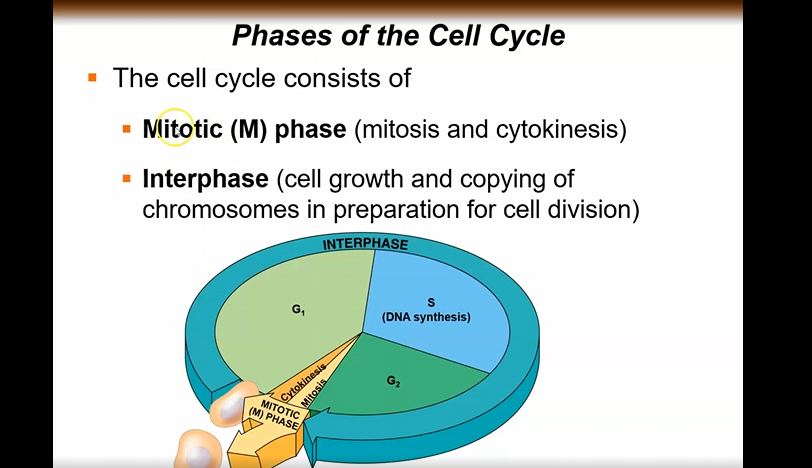Cell Cycle and Mitosis Overview
The Key Roles of Cell Division
Cell division is crucial in distinguishing living organisms from nonliving matter.
Unicellular organisms: division of one cell leads to the reproduction of the entire organism.
Multicellular eukaryotes: rely on cell division for:
Development from a fertilized cell
Growth
Repair
Cell division is a central component of the cell cycle, which represents the life cycle of a cell from its formation through to its division.
Chromosomal Structure and Genetic Material
The genome of a cell comprises all its DNA.
Can be a single DNA molecule (prokaryotic cells) or multiple DNA molecules (eukaryotic cells).
DNA in eukaryotic cells is organized into chromosomes.
Chromosomes in eukaryotic cells are composed of chromatin, a combination of DNA and protein that condenses during division.
Each eukaryotic species has a definitive number of chromosomes:
Humans: 46 chromosomes
Cabbage: 18 chromosomes
Elephants: 56 chromosomes
Hedgehogs: 90 chromosomes
Carp: 104 chromosomes
Types of Cells
Somatic cells (non-reproductive) have two sets of chromosomes.
Gametes (reproductive cells: sperm and eggs) carry half the number of chromosomes compared to somatic cells.
Overview of Eukaryotic Cell Division
In preparation for cell division:
DNA is replicated, leading to visible chromatin packaged as chromosomes.
Each duplicated chromosome consists of two sister chromatids connected by cohesins.
The centromere is the region where the chromatids are most tightly bound.
Stages of the Cell Cycle
Cell Cycle Phases

The cell cycle comprises:
Mitotic (M) phase (includes mitosis and cytokinesis)
Interphase:
G1 phase: First gap
S phase: Synthesis (chromosome duplication)
G2 phase: Second gap
Interphase lasts approximately 90% of the cycle, with chromosome duplication only occurring during the S phase.
Mitosis Phases
Interphase is prior to mitosis
Mitosis occurs in 5 stages:
Prophase - chromosomes start condensing , the mitotic spindle begins to form, and the nuclear envelope starts to break down.
Prometaphase - the chromosomes become even more condensed, and the microtubules attach to the kinetochores on the chromosomes.
Metaphase - chromosomes line up across the center of the cell so each sster chromatid is alligned
Anaphase - sister chromatids sperate and mov towards the centromere
Telophase - chromosomes art at each end of the cell, nuclues sorrounds them, cytoplasm starts to divide
The Mitotic Spindle
The mitotic spindle is crucial for chromosome movement during mitosis and is formed from microtubules.
hollow tubes made from tubilin
aster - radial array of short microtubulues that extends from each centrosome
kinetochores - protein structures on the chromosome that attach to the mitotic spindle,
Centrosomes: Organizing centers of microtubules that form the spindle.
Key Points of Mitosis
During prometaphase, spindle microtubules attach to the kinetochores of chromosomes.
In anaphase, sister chromatids are pulled apart toward opposite cell poles due to action of microtubules and separation of cohesins.
enzyme called separase makes them move to opposite ends of the cell
Telophase sees the formation of daughter nuclei.
Cytokinesis in Animal and Plant Cells
Animal cells: Cytokinesis occurs via cleavage furrow formed by a contractile ring of actin and myosin.
Plant cells: Vesicles form a cell plate, which develops into a new cell wall dividing the daughter cells.
Binary Fission in Prokaryotes
Prokaryotes divide through binary fission:
Chromosome replicates and origins move to opposite sides; then, the cell membrane pinches inward.
Cell Cycle Regulation
Cell division frequency varies among cell types (e.g., skin cells divide more frequently than nerve cells).
The cell cycle control system regulates the process via chemical signals and checkpoints:
Major checkpoints: G1, G2, and M phases.
Cyclins and Cyclin-Dependent Kinases
Cyclins and cyclin-dependent kinases (Cdks) are regulatory proteins that control the cell cycle progression.
The activity of Cdks fluctuates with cyclin concentrations.
MPF (maturation-promoting factor) mediates the G2 to M phase transition.
Cancer and Cell Cycle Regulation
Cancer cells evade normal regulatory mechanisms and divide uncontrollably.
Characteristics of cancer cells:
May not require growth factors.
Can lead to tumor formation (benign or malignant).
Metastasis refers to the spread of cancer cells to distant parts of the body.
Treatment of Cancer
Localized tumors can be treated with radiation, while chemotherapy targets cell cycle processes.
Example: Taxol stabilizes microtubules, halting mitosis, affecting both cancerous and normal rapidly dividing cells.
Advances in molecular understanding are aiding in the development of personalized cancer treatments.